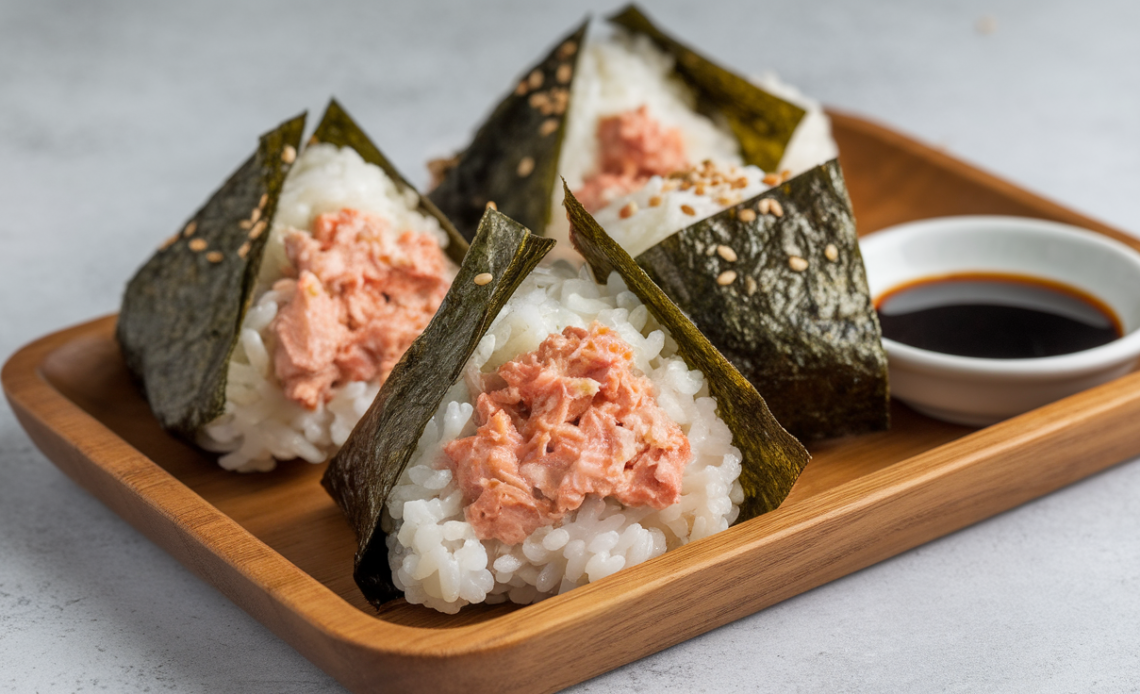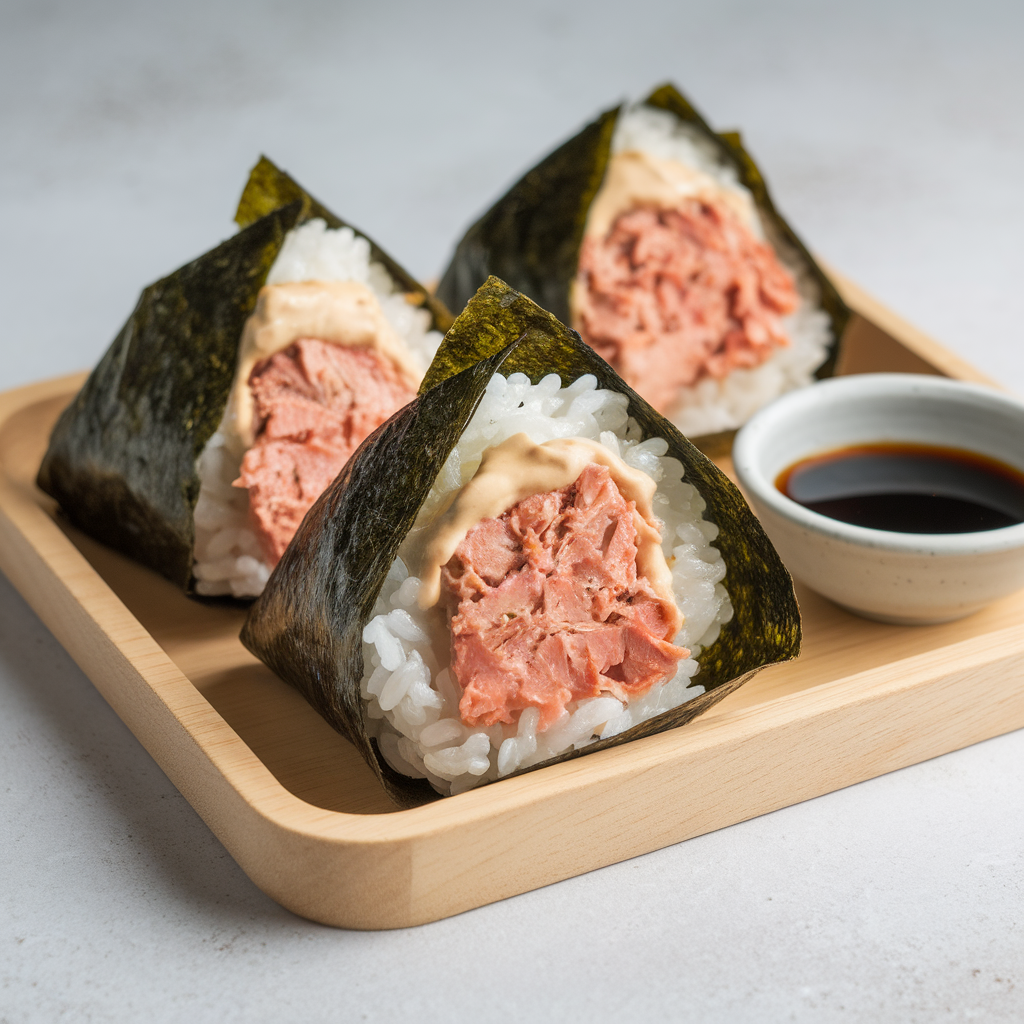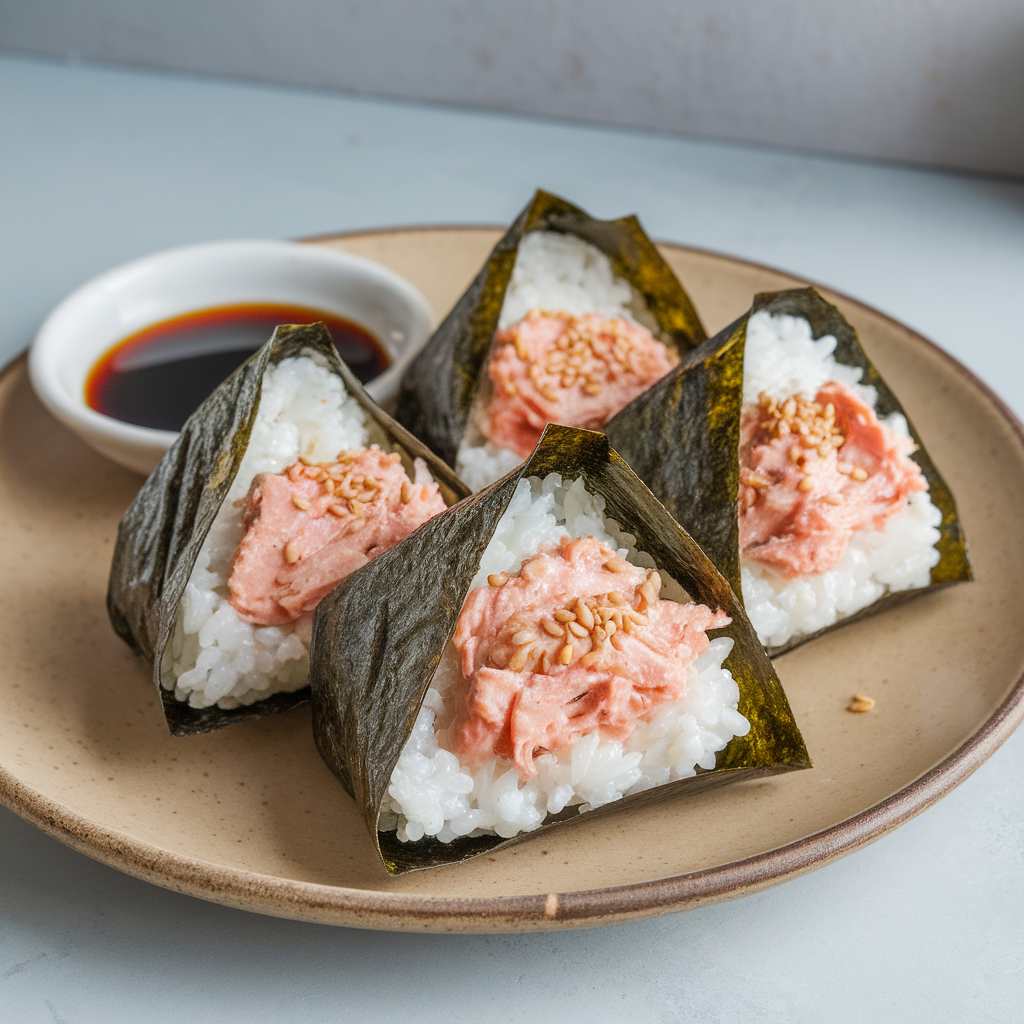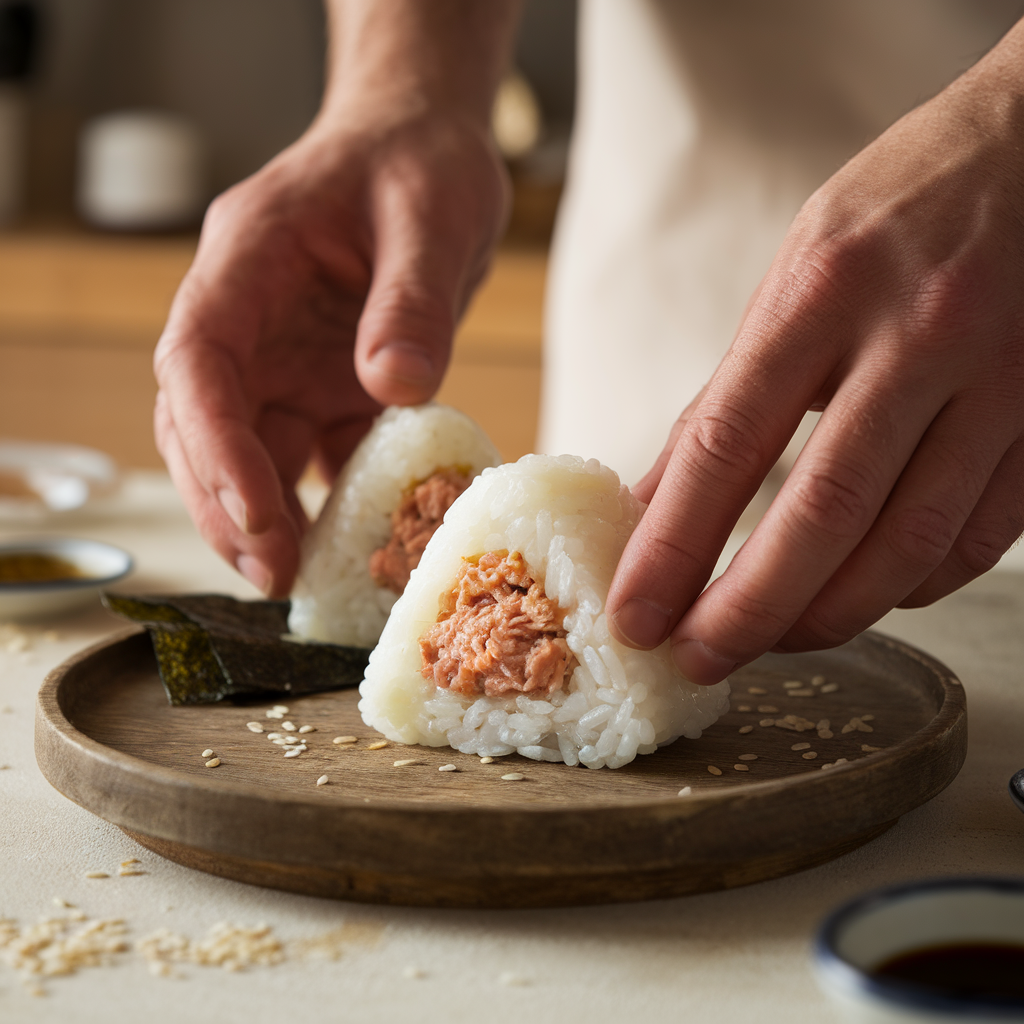
If you’re craving a savory, satisfying snack that’s both portable and nutritious, look no further than Tuna Mayo Rice Balls, also known as Tuna Mayo Onigiri in Japan. These popular rice balls are a staple in Japanese convenience stores and lunch boxes (bento). Simple to prepare and packed with flavor, they’re perfect for picnics, school lunches, meal prep, or a healthy afternoon pick-me-up. This recipe brings together creamy tuna mayo and seasoned sushi rice wrapped in crispy nori (seaweed) for a snack that feels indulgent yet wholesome.
In this comprehensive guide, we’ll explore the recipe in full detail, from the sushi rice base to the flavorful tuna filling, shaping tips, storage advice, and creative variations. Whether you’re new to Japanese cuisine or a long-time fan of rice snacks, you’ll discover everything you need to make the perfect Tuna Mayo Onigiri at home.
🥢 What Is Tuna Mayo Onigiri?
Onigiri, or Japanese rice balls, are hand-formed balls or triangles of rice typically filled with savory ingredients and wrapped in nori. They’re a beloved snack in Japan and have gained international popularity for their versatility, convenience, and delicious taste.
Tuna Mayo Onigiri is one of the most common and beloved varieties. It features a creamy, savory filling made from canned tuna mixed with Japanese mayonnaise, sometimes enhanced with soy sauce or a bit of wasabi. The rice is shaped into a triangle or oval and optionally coated with sesame seeds for extra flavor and crunch.
🍱 Why You’ll Love This Recipe
- Easy to Make: No complicated tools or ingredients required.
- Customizable: Adjust the filling to your liking—spicy, garlicky, or even with added veggies.
- Healthy: Packed with protein, omega-3s, and low in saturated fats.
- Kid-Friendly: Mild flavors and fun shapes make these a hit in lunchboxes.
- Portable: Great for work lunches, travel snacks, or post-gym meals.

📝 Ingredients You’ll Need
For the Sushi Rice:
- 2 cups short-grain sushi rice
- 2 ½ cups water
- 3 tablespoons rice vinegar
- 1 tablespoon sugar
- 1 teaspoon salt
For the Tuna Mayo Filling:
- 1 can (5 oz) tuna in water or oil, drained
- 2 tablespoons Japanese mayonnaise (e.g., Kewpie)
- ½ teaspoon soy sauce (optional)
- ½ teaspoon rice vinegar or lemon juice (optional)
- Pinch of salt and pepper
To Assemble:
- Nori seaweed sheets, cut into strips or squares
- Toasted sesame seeds (optional)
- Salt for your hands (to prevent sticking)
🍚 Step-by-Step Instructions
Step 1: Prepare the Sushi Rice
- Rinse the Rice: Wash the sushi rice in cold water several times until the water runs clear. This removes excess starch and prevents mushiness.
- Cook the Rice: Add the rinsed rice and water to a rice cooker or pot. Cook according to package instructions or until all water is absorbed and the rice is tender.
- Season the Rice: In a small saucepan, combine rice vinegar, sugar, and salt. Gently heat until dissolved. Pour over the cooked rice and gently fold with a rice paddle or fork. Let it cool to room temperature.
Step 2: Make the Tuna Mayo Filling
- In a mixing bowl, add drained tuna, Japanese mayo, soy sauce (if using), and a touch of vinegar or lemon juice.
- Mix until smooth and creamy. Adjust seasoning to taste.
Step 3: Shape the Onigiri
- Set Up Your Station: Have a bowl of cold water, a small bowl of salt, and your tuna filling ready.
- Wet Your Hands: Dip your hands in water and rub a pinch of salt between your palms. This keeps the rice from sticking and lightly seasons the outside.
- Add Rice: Take about ½ cup of rice and flatten it into a disk in your palm.
- Add Filling: Spoon 1–2 teaspoons of the tuna mayo mixture into the center.
- Form the Shape: Gently fold the rice around the filling and shape into a triangle or oval. Be careful not to press too hard or the rice may become too dense.
- Wrap in Nori: Place a strip or square of nori on the base or wrap it around the rice ball completely.
- Optional Coating: Sprinkle with toasted sesame seeds for a nutty crunch.

🔁 Variations to Try
- Spicy Tuna Mayo: Add sriracha or a pinch of chili flakes to the filling.
- Avocado Tuna: Mix mashed avocado with the tuna for a creamy twist.
- Garlic Herb: Add a touch of minced garlic and chopped parsley.
- Cheesy Center: Place a small cube of mozzarella or cream cheese inside.
- Furikake Rice Balls: Mix Japanese furikake seasoning into the rice for added umami.
🧊 Storage Tips
- Fridge: Store wrapped onigiri in plastic wrap or in an airtight container in the refrigerator for up to 24 hours. For best texture, bring to room temperature before eating.
- Freezer: You can freeze onigiri without nori for up to one month. Reheat in the microwave and wrap with fresh nori before serving.
Tip: Nori becomes soggy when wrapped in advance. If you’re packing these for later, store the nori separately and wrap just before eating for best texture.
🌿 Nutrition Benefits
Tuna Mayo Rice Balls may be small, but they’re nutritionally dense:
- Protein: Tuna provides lean protein and heart-healthy omega-3 fatty acids.
- Low in Saturated Fat: Using Japanese mayo, which is made from egg yolks and rice vinegar, offers richness without being overly greasy.
- Complex Carbs: Sushi rice offers sustained energy.
- Customizable Fillings: Add veggies like cucumber, carrots, or avocado for extra fiber.
This makes them a great option for:
- Healthy post-workout snacks
- Light, balanced lunches
- Kid-friendly meals with whole food ingredients
🎌 Japanese Origins and Cultural Context
Onigiri has been a part of Japanese culinary culture for centuries. These rice balls were originally used as travel food, thanks to their convenience and portability. Today, they’re a daily staple found in convenience stores (konbini) across Japan, featuring a wide array of fillings from pickled plum (umeboshi) to grilled salmon.
Tuna Mayo, despite being a more modern, Western-influenced addition, has become one of the most popular varieties due to its creamy, comforting flavor.

🥄 Serving Suggestions
- Pair with miso soup for a light meal.
- Serve with a side of pickled ginger, edamame, or cucumber salad.
- Add to bento lunch boxes with sliced fruit, tamagoyaki (Japanese rolled omelet), and steamed veggies.
- Sprinkle with shichimi togarashi (Japanese chili seasoning) for extra spice.
🧂 Pro Tips for the Best Onigiri
- Use Short-Grain Rice: Long-grain rice won’t stick well enough to hold the shape.
- Don’t Overfill: Too much filling will cause the rice ball to fall apart.
- Wet and Salt Your Hands: Prevents sticking and adds flavor.
- Shape Gently: Compress just enough to hold its form without mashing the grains.
- Use Plastic Wrap for Shaping: If you’re nervous about sticky hands, place rice on a piece of cling wrap, add filling, and twist to form a ball.
🧁 Make It a Meal Prep Hero
Double or triple the batch and refrigerate or freeze extras. Tuna Mayo Onigiri is ideal for:
- Lunch prep for busy school or office days.
- Quick snacks that are filling and balanced.
- Party platters with different fillings for guests to choose from.
🍥 Frequently Asked Questions
Can I use regular mayonnaise instead of Japanese mayo?
Yes, but Japanese mayo (like Kewpie) has a richer, slightly sweeter taste. You can mimic it by adding a touch of rice vinegar or lemon juice to regular mayo.
Is sushi rice necessary?
Yes, it’s recommended. Sushi rice is sticky and holds shape well, unlike long-grain or jasmine rice which may fall apart.
Can I make this vegan?
Absolutely! Use mashed chickpeas or mashed tofu with vegan mayo for a similar texture and taste.
🧡 Final Thoughts
Tuna Mayo Onigiri offers everything we love in a snack: it’s healthy, customizable, comforting, and portable. Whether you’re looking to bring more Asian-inspired dishes into your kitchen, or simply want a quick protein-rich bite between meals, these rice balls are a go-to.
Make them once, and you’ll find yourself reaching for this recipe again and again. They’re not just rice snacks—they’re little bundles of joy!
📌 Try This Easy Tuna Mayo Rice Ball Recipe Today!
Perfect for healthy lunches, quick snacks, and fun bento box creations—Tuna Mayo Onigiri is a Japanese classic you’ll crave again and again.




